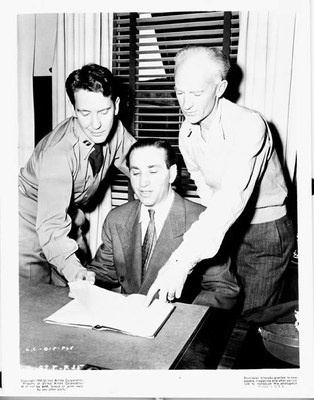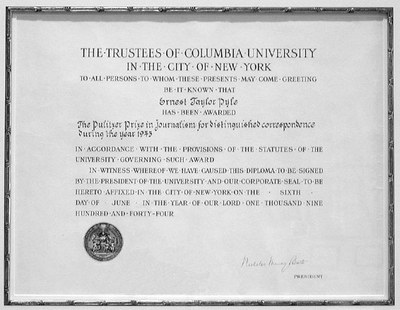America's Most Loved Reporter: Ernie Pyle
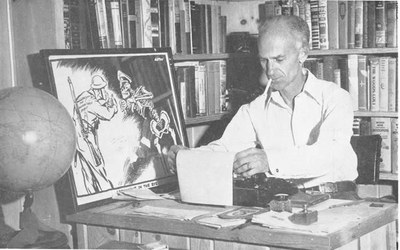
For the first time, the Albuquerque Museum presents a compilation of images, documents and memorabilia preserved through the years by the City of Albuquerque’s Cultural Services Department. These collections complement those held in the archives of the Ernie Pyle State Historic Site in Dana, Indiana; the Indiana University School of Journalism in Bloomington; and numerous New Mexico collections.
The Museum wishes to acknowledge those who contributed images, artifacts, and resources to produce this exhibit, including the Ernie Pyle and Special Collections Branches of the Albuquerque/Bernalillo County Library System, Acme Newspictures Inc., Indiana University School of Journalism, Dick Ruddy Photography, William Sloane Associates, Inc., and University of New Mexico students Amanda Denning and Melissa Mann.
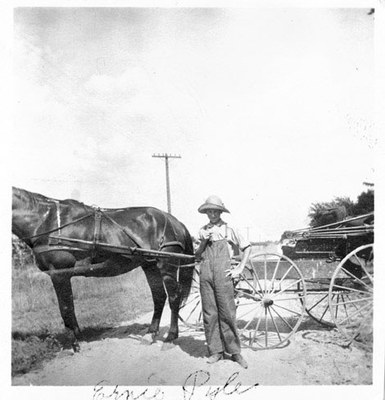
Why Albuquerque?
"We like it here because we’re on top of the world, in a way; and because we are not stifled and smothered and hemmed in by buildings and trees and traffic and people. We like it because the sky is so bright and you can see so much of it. And because out here you actually see the clouds and the stars and the storms, instead of just reading about them in the newspapers." — Ernie Pyle, "Why Albuquerque?,"1942
Ernie Pyle was born on August 3, 1900 and grew up on a farm just outside of Dana, Indiana. As a teenager, Pyle hated farming and shortly after graduating from high school, he enlisted in the Naval Reserve. He enrolled in Indiana University in 1919 but, just before finishing his degree, the LaPorte Herald hired him as a reporter. He then joined the staff of the Washington (D.C.) Daily News, part of the Scripps-Howard newspaper chain.
In 1925, Pyle married Minnesota native Geraldine (Jerry, "That Girl") Siebolds. Quitting their jobs, the Pyles traveled 9,000 miles in ten weeks, and by 1927 they had crossed the country 35 times while Ernie wrote columns on the road for Scripps-Howard. After years of wandering, they unanimously selected their town of choice – Albuquerque – in which to build a home.
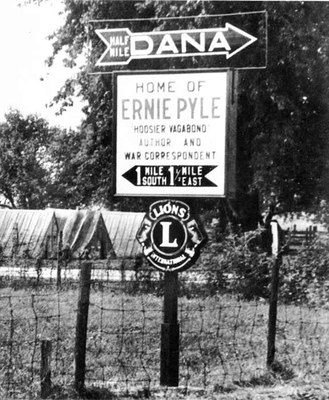
Readers loved Ernie Pyle’s informal and comfortable writing style. Reporting from the front lines during World War II, he wrote not of battle statistics but about the daily lives of common soldiers in the trenches.
Reporting the War
"I love the infantry because they are the underdogs. They are the mud-rain-frost-and-wind boys. They have no comforts, and they even learn to live without the necessities. And in the end they are the guys that wars can't be won without." — Ernie Pyle, "The God-Damned Infantry," 1943
During their travels, Ernie Pyle compiled notes about interesting individuals and wrote columns while Jerry typed them on a portable typewriter. After 1937 Ernie hit the road alone, leaving Jerry in Albuquerque to keep the home fires burning. By 1942 she worried about his safety while he drafted and typed columns from abroad, covering operations in England and North Africa, Sicily, Italy and France.
Pyle’s columns covered almost every branch of the service, but he most highly praised the common foot soldier. He even publicly supported a bill to provide extra "fight pay" for soldiers performing combat service.
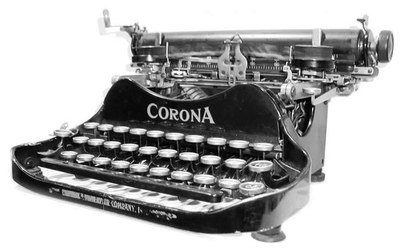
Ernie Pyle interviewed Sergeant Don Bell, a rodeo rider, in June or July 1944 outside of St. Lo, France. Bell recalled that the foxhole they shared caved in during German shelling. Pyle said, "I have my notes, but my little portable typewriter is buried in that hole." They hurriedly abandoned the foxhole, leaving the typewriter behind.
Sgt. Bell later salvaged it, kept it through the war, and donated it to the Museum in 1990. A photograph of Pyle in Normandy, typing on an Underwood, may have been taken after this event.
Bell recalled the interview as comforting. He wrote, "…Ernie had taken my ma’s wisdom and turned it into a soldier’s lesson: to find strength in battle you take hold of strength you’ve known at home…and of the faith that underlies it."
Lost a Buddy
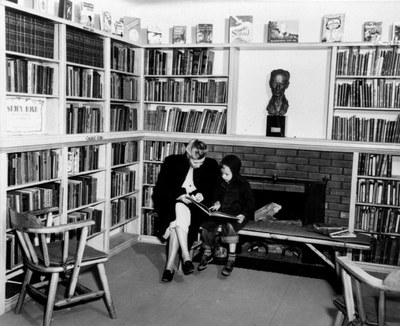
"My one regret of the war is that I was not with them when it ended." – Ernie Pyle, "On Victory
in Europe," 1945
After returning home from the liberation of Paris, Pyle accepted what was to be his last assignment – covering the war in the Pacific with the Navy and Marines. On April 18, 1945, while ducking into a ditch on Ie Shima, he was suddenly hit by a Japanese machine-gunner’s bullet and died instantly.
Ernie Pyle didn’t measure his self-worth by how much he was paid, nor by the number of opportunities for publicity. He did, however, care about his readership. By the time of his death, Ernie’s columns appeared in 400 daily and 300 weekly newspapers. Upon word of the tragedy, memorials were erected and services were held worldwide. Soldiers in Ie Shima paid tribute by erecting a simple sign that read, "At this spot, the 77th Infantry Division lost a Buddy, Ernie Pyle, 18 April 1945."
Plagued by bouts of illness and depression, Jerry Pyle passed away only seven months after her husband. Heirs of the Pyle estate eventually donated the property to the City of Albuquerque, and in 1948 the Pyle House opened to the public as a branch of the Albuquerque Public Library.
Thank You
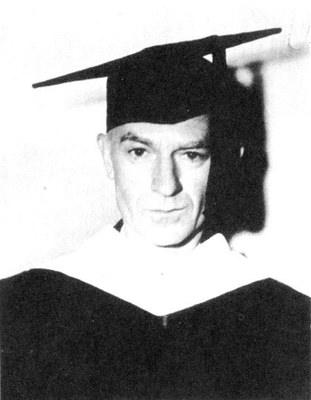
"I Am Pleased, You Bet." — Ernie Pyle, Ph.D., 1944
During his lifetime, Ernie Pyle received numerous honors and awards. Honored early in his career as well as posthumously, while serving abroad and while at home, Pyle shyly avoided the public whenever possible. Upon receiving an honorary Doctor of Letters from the University of New Mexico, he could only squeak out a nervous, "Thank you." Later, grinning, he admitted, "I am pleased; you bet!" A month later, he endured a repeat performance while being awarded a Doctor of Humane Letters from Indiana University, the first such degree ever bestowed.
The Pulitzer Foundation was aware of Pyle’s abilities as early as 1933, when he won honorary mention for his column on a coal miners’ strike in Gallup. Eleven years later, he was awarded the Pulitzer Prize in Journalism for his World War II columns of 1943, which were published as Here is Your War (1943) and Brave Men (1944). Next to serving with his buddies in the trenches, winning the Pulitzer was perhaps the reporter’s highest honor.
Among numerous other honors and opportunities, he collaborated with producer Lester Cowan and director William Wellman on The Story of G.I. Joe, with actor Burgess Meredith starring as Ernie Pyle. Though he didn’t like the title, Pyle felt the film might be a hit. A huge success, The Story of G.I. Joe premiered in Albuquerque in July 1945 just two months after his death.
